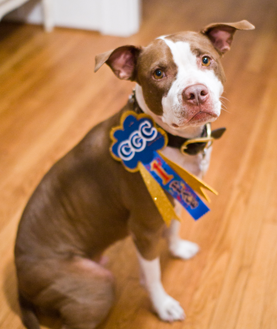Canine Good Citizen Test
The canine good citizen test is a test you and your canine companion can take. As an owner the test shows you are a responsible pet owner who agrees to take care of their canine’s health, safety, exercise, training, and quality of life. As an owner, you will also agree to take responsibility by cleaning up after your pooch in a public place and by never letting your canine infringe on the rights of others: human, canine etc.
For your canine to be granted the CGC, he/she will have to do some of if not all of the following:
1.Accept a friendly stranger
To accept a friendly stranger, your pooch must allow someone to approach not only the canine but the handler as  well in a natural everyday situation. The dog must show zero signs of shyness or resentment.
well in a natural everyday situation. The dog must show zero signs of shyness or resentment.
2.Sitting politely for patting
This requirement is in place to show that your canine can allow a friendly stranger to touch it without its owner or handler.
3.Appearance and grooming
To pass this stage, your canine will have to welcome being groomed and examined. Your canine will also have to show it will permit someone, e.g., a veterinarian or family friend, to do so.
4.Walking on a loose lead
Here you have to show that you are in control of your canine. It does not matter which side of you your canine walks as long as the canine’s position leave no doubt that he/she is attentive to you. Your canine will also have to show that he/she responds to your movements and changes in direction.
5.Walking through a crowd
Here your canine will have to show he/she can move about through pedestrian traffic in a polite manner.
6.Sit down on command and staying in place
This test is to demonstrate the fact your canine does have training. Your canine must be able to demonstrate these commands to pass the CGC.
7.Coming when called
This test shows a sign of respect to you from your canine companion. If your pooch does not come when called, you still have some work to do.
8.Reactions to other dogs
Here your canine must prove he/she can behave in a polite manner around other dogs. Your dog should show no more than a casual interest in another dog.
9.Reactions to distractions
A reaction to distractions means your canine is confident at all times when faced with typical distracting situations. Examples of distractions include, but are not limited to, joggers running past the dog, dropping a chair, or moving something past the dog. Natural interest or curiosity is fine but any form of panic, aggressiveness or barking is not acceptable.
10.Supervised separation
Here your canine has to show that he/she is comfortable with being left with a trusted person whilst maintaining his/her training and good manners.
If your dog is capable of all of these things, then you will find you are eligible for the CGC.






